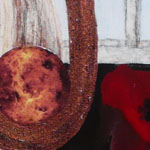American Moor on the Campuses of
Mount Holyoke College, University of Massachusetts,
and Amherst, 11/2 – 11/15/18…
So this was new…
Fourteen days over three campuses, five performances of American Moor, and classroom interaction in classes ranging from “Intro to Literature” and “History of Performance” to “Diversity, Inclusion, and Everyday Democracy” and “Race, Racism and Power,” a round table discussion, a symposium or two… We sat and spoke with renowned scholars and visual artists. My play and I had never done anything like this before. The visitor to the web page here can scroll down and read about other college engagements. They all had purpose and value.

Top three photos credit: Jon Crispin
Clockwise from center: Director, Kim Weild; Scholar, Kim F. Hall; Umass Professor, Marjorie Rubright
Lower Left: Artist, Curlee Raven Holten, and Mt. Holyoke Art Museum Director, Tricia Y. Paik
Upper Center: Mt. Holyoke Professor, Amy Rodgers, and Curlee Raven Holten, visual artist and Director of the David C. Driskell Center, University of Maryland
But this was another animal entirely. It was as if American Moor served as the nexus for any number of disciplines to converge and understand their place in this story. A Muslim student from Saudi Arabia stopping me on campus wept to discover upon seeing a performance that “his” story was her story, that she could not be the fully actualized individual in her new life as an American college student. Another small woman—a student as unlike me in age, gender, race, and life experience as any two people could be—steps up to speak with me after a symposium. She’s tracked the protagonist’s sore shoulder from the opening of the play through where, driving towards the last third, he speaks of how his injury now impedes upon his dreams because, aging, his body will no longer do the work to repair itself so well, and she tells me that she is a violinist and a good one, and that she doesn’t know, even as young as she is, if her shoulder will allow her to be a great violinist, and that she is afraid.
I don’t know what else to say…
Two Mount Holyoke students took me to breakfast. They wanted me to account for how Desdemona is addressed in my play, or, just as important, how she is NOT addressed, and only referred to, for the most part as they had perceived it, through images of violence against women. I’m still wondering if they were satisfied with my answers. Ultimately, it was, for me, just another instance of viewers finding themselves somewhere in the play, and wanting to defend, define, deny, or discuss their complicity.
This is mostly a document in photos and short video clips. I’m hoping they can tell the story better than I can. It’s not my favorite thing to tell the story at all, but I hope rather that it begins to tell itself if we just keep showing up. I can’t pretend that everything that audiences are finding in this play I intentionally put there… but something did… Documenting these endeavors as they come and go by is my responsibility to whatever thing has done that.
Holyoke Post-Perf Comment (Complicity) from Keith Hamilton Cobb on Vimeo.
Holyoke Post-Perf Comment (Dir. Modality) from Keith Hamilton Cobb on Vimeo.
Amherst Professor Comment Post-Perf from Keith Hamilton Cobb on Vimeo.


































